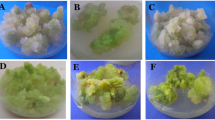Abstract
Peach [Prunus persica (L.) Batsch] regenerants from cv ‘Sunhigh’ embryo no. 156, regenerants obtained from cv ‘Redhaven’ embryo no. 30, and two peach cultivars ‘Sunhigh’ and ‘Redhaven’, were screened for polymorphic RAPD (Random Amplified Polymorphic DNA) markers with up to 60 10-mer primers. Although 35 primers produced results with scoreable bands, only 10 of the primers revealed polymorphism for regenerants of embryo no. 156 and cv ‘Sunhigh’, and 1 revealed a low level of polymorphism for regenerants of embryo no. 30 and cv ‘Redhaven’. This study demonstrates the feasibility of using RAPD markers to identify somaclonal variants of peach and provides evidence for the existence of genetic differences among these variants.
Similar content being viewed by others
Abbreviations
- PCR :
-
Polymerase chain reaction
- RAPD :
-
random amplified polymorphic DNA
- RFLP :
-
Restriction fragment length polymorphism
- CTAB :
-
cetyltrimethyl ammonium bromide
- PVP :
-
polyvinyl pyrolidone
- dNTP :
-
deoxy-ribonucleotide triphosphate
References
Baird E, Cooper-Bland S, Waugh R, DeMaine M, Powell W (1992) Molecular characterization of inter- and intra-specific somatic hybrids of potato using randomly amplified polymorphic DNA (RAPD) markers. Mol Gen Genet 233:469–474
Cecchini E, Natali L, Cavallini A, Durante M (1992) DNA variations in regenerated plants of pea (Pisum sativum L.) Theor Appl Genet 84:874–879
Chaparro JX, Werner DJ, O'Malley D, Sederoff RR (1994) Targeted mapping and linkage analysis of morphological, isozyme and RAPD markers in peach. Theor Appl Genet 87:805–815
Durante M, Geri C, Grisvard J, Guille E, Parenti R, Buiatti M (1983) Variation in DNA complexity inNicotiana glauca tissue cultures. I. Pith tissue dedifferentiation in vitro. Protoplasma 114:114–118
Hammerschlag FA (1990) Resistance responses of plants regenerated from peach callus cultures toXanthomonas campestris pv.pruni. J Amer Soc Hortic Sci 115:1034–1037
Hammerschlag FA, Bauchan GR, Scorza R (1985) Regeneration of peach plants from callus derived from immature embryos. Theor Appl Genet 70:248–251
Hammerschlag FA, Bauchan GR, Scorza R (1987) Factors influencing in vitro multiplication and rooting of peach cultivars. Plant Cell Tiss Org Cult 8:235–242
Hashmi G, Hammerschlag FA, Huettel R, Krusberg L (1995) Growth, development, and response of peach somaclones to the root-knot nematode,Meloidogyne incognita. J Amer Soc Hort Sci 120:932–937
He S, Ohm H, Mackenzie S (1992) Detection of DNA sequence polymorphisms among wheat varieties. Theor Appl Genet 84:573–578
Isabel N, Tremblay L, Michaud M, Tremblay FM, Bouquet J (1993) RAPDs as an aid to evaluate the genetic integrity of somatic embryogenesis-derived populations ofPicea mariana (Mill.) B.S.P. Theor Appl Genet 86:81–87
Klein-Lankborst RM, Vermunt A, Weide R, Liharska T, Zabel P (1991) Isolation of molecular markers for tomato (L. esculentum) using random amplified polymorphic DNA (RAPD). Theor Appl Genet 83:108–114
Larkin PJ, Scowcroft WR (1981) Somaclonal variation — A novel source of variability from cell cultures for plant improvement. Theor Appl Genet 60:197–214
Lorz H (1984) Variability in tissue culture derived plants. In: Arber W (ed) Genetic manipulation: impact on man and society. Cambridge University Press, Cambridge, pp 103–114
Lu Z, Reighard GI, Baird WV, Abbott AG, Rajapakse S (1996) Identification of peach rootstock cultivars by RAPD markers. Hort-Science 31:127–129
McCoy TJ, Phillips RL, Rines HW (1982) Cytogenetic analysis of plants regenerated from oat (Avena sativa) tissue cultures; high frequency of partial chromosome loss. Can J Genet Cytol 24:37–50
Muller E, Brown PTH, Hartke S, Lorz H (1990) DNA variation in tissue-culture-derived rice plants. Theor Appl Genet 80:673–679
Munthali MT, Newbury HJ, Ford-Lloyd BV (1996) The detection of somaclonal variants of beet using RAPD. Plant Cell Rep 15:474–478
Phillips RL, Kaeppler SM, Peschke VM (1990) Do we understand somaclonal variation. In: Van Der Plas LHW, Van Aartrijk J (eds) Progress in plant cellular and molecular biology. Kluwer Academic Publ, Dordrecht, pp 131–141
Rajapakse S, Belthoff LE, Hr G, Estager AE, Scorza R, Verde I, Ballard RE, Baird WV, Callahan A, Monet R, Abbott AG (1995) Genetic linkage mapping in peach using morphological, RFLP and RAPD markers. Theor Appl Genet 90:503–510
Reiter RS, Williams J, Feldmann KA, Rafalski JA, Tingey SV, Scolnik PA (1992) Global and local genome mapping inArabidopsis thaliana by using recombinant inbred lines and random amplified polymorphic DNA's. Proc Natl Acad Sci USA 89:1477–1481
Rogers SO, Bendich A (1985) Ribosomal genes in plants: variability in copy number and in the intergenic spaces. Plant Mol Biol 5:69–76
Sabir A, Newbury HJ, Todd G, Catty J, Ford-Lloyd BV (1992) Determination of genetic stability using isozymes and RFLP's in beet plants regenerated in vitro. Theor Appl Genet 84:113–117
Vierling RA, Nguyen HT (1992) Use of RAPD markers to determine the genetic diversity of diploid wheat genotypes. Theor Appl Genet 84:835–838
Warburton ML, Bliss FA (1996) Genetic diversity in peach (Prunus persica L. Batsch) revealed by randomly amplified polymorphic DNA (RAPD) markers and compared to inbreeding coefficients. J Amer Soc Hortic Sci 121:1012–1019
Williams JGK, Kubelik AR, Livak KJ, Rafalski JA, Tingey SV (1990) DNA polymorphisms amplified by arbitrary primers are useful as genetic markers. Nucleic Acids Res 18:6531–6535
Yang X, Quiros C (1993) Identification and classification of celery cultivars with RAPD markers. Theor Appl Genet 86:205–212
Author information
Authors and Affiliations
Additional information
Communicated by R. N. Trigiano
Rights and permissions
About this article
Cite this article
Hashmi, G., Huettel, R., Meyer, R. et al. RAPD analysis of somaclonal variants derived from embryo callus cultures of peach. Plant Cell Reports 16, 624–627 (1997). https://doi.org/10.1007/BF01275503
Received:
Revised:
Accepted:
Issue Date:
DOI: https://doi.org/10.1007/BF01275503




